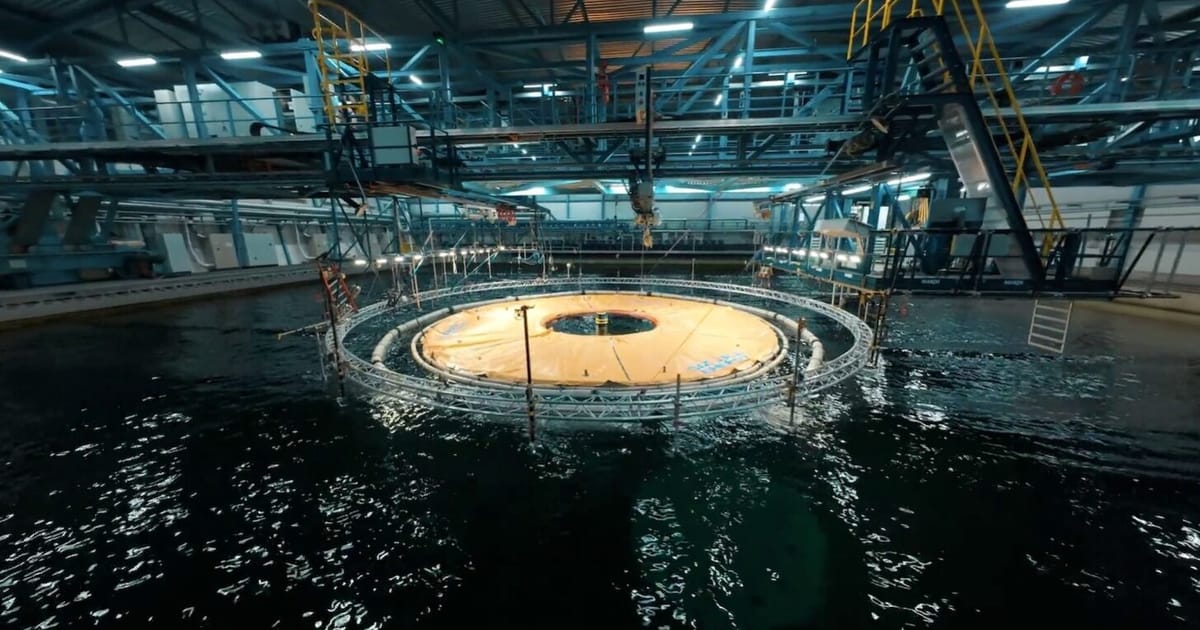Any company that wants to compete in long-duration storage has to find materials and designs that make it dirt cheap to add hours of capacity. Traditional pumped hydro does this by filling a large reservoir with water. Sizable chose a double-walled membrane to fill with brine, which fits the cheap and scalable bill. Adding more vertical feet of plastic pipe is pretty inexpensive, too.
The power equipment costs less than 700 euros ($810) per kilowatt in the long term, competitive with pumped hydro, Aufiero said. Where the technology really shines is in the marginal cost of adding more storage duration: less than 20 euros ($23) per kilowatt-hour, at scale. That’s right on par with what Form Energy is targeting with its iron-air battery, an attempt at a mass-produced electrochemical battery for 100 hours of duration.
Sizable is shooting for eight hours to 24 and beyond. The economics improve at a larger scale: If you’ve got to install a mooring system and connect a marine cable to the grid, you might as well ship more power through it rather than less.
That’ll take some time to work up to. Sizable already built a kilowatt-scale proof of concept, which it floated at the Natural Ocean Engineering Laboratory in Reggio Calabria, Italy. In September, the company subjected its design to a bombardment of artificial waves in the gigantic pool at the Maritime Research Institute Netherlands, which vets the durability of marine engineering. The successful performance in those tests set the stage for the recent fundraising round.
With the cash infusion, the team is building a 1-megawatt device, which will sport a 50-meter (164-foot) radius and occupy up to 500 meters (1,640 feet) of ocean column off the coast of Reggio Calabria.
Sizable is funding this project itself, since it can’t yet show financiers the real-world performance data they need to underwrite investment. It will be fully functional, using scaled-down components because of its diminutive size, but it won’t connect to the grid. Sizable has already secured a 10-megawatt grid connection in southern Italy for its first truly commercial development.
Survive the ocean, but keep it simple
The unenviable challenge facing Aufiero is to fortify his invention against the torments of the sea, without spending so much money armoring it that it loses its low cost.
“Doing something in the ocean, it is a challenge, but it’s also an opportunity for massive scalability,” Aufiero said. He set out to design a “simple system that can be scaled without too many surprises.”
Wave action has literally sunk many hopeful ocean-energy pilot projects. But such devices in the past sought to harness the renewable power of the waves through direct contact. Sizable Energy only needs the ocean as a uniform space to operate in, so its technology tries to minimize wave contact as much as possible.
Two outer rings of plastic pipe were engineered to disrupt waves before they hit the floating reservoir. In the event that strong surf or heavy rain threatens to weigh down the reservoir, bilge pumps activate to clear out the liquid.
In Europe, people have been leasing seabed for energy projects at grand scale for decades. Sizable will apply to the same regulatory bodies that oversee offshore wind, but needs a much smaller footprint per megawatt.
In fact, offshore wind farms are an attractive potential site for the startup’s contraption, Aufiero said. By colocating, Sizable could share the export cables, and firm up the booms and busts of wind generation by storing it locally and distributing it to the grid as needed. Leak, the investor, likened this pairing to transforming an offshore wind plant into a nuclear power plant by converting variable generation into predictable, baseload clean energy.
For their part, the lead investors at Playground Global find the challenge of surviving Neptune’s wrath exhilarating.
“As engineers, we love things that are hard,” Leak told me. “If it’s a good idea that anybody can do, what’s your difference?”
{
if ($event.target.classList.contains(‘hs-richtext’)) {
if ($event.target.textContent === ‘+ more options’) {
$event.target.remove();
open = true;
}
}
}”
>
